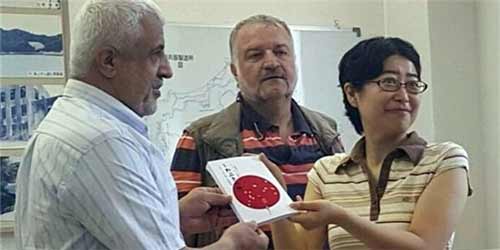Iranian Artists, Writers in Japan to Commemorate US Atomic Bombing of Hiroshima, Nagasaki
2015-8-10
TEHRAN (FNA)- A group of Iranian artists and writers traveled to Hiroshima to honor the victims of the 1945 US atomic bombing of Japan.
The Iranian artists and writers participated in the ceremonies marking the 70th Anniversary of Hiroshima A-bombing by the US at the end of World War II.

The Japanese translation of a book on Iranian chemical victims of the 1980-88 Iran-Iraq war was also unveiled in Hiroshima.
On August 6, 1945 US bomber B-29 Enola Gay dropped a four-ton uranium bomb codenamed Little Boy on Hiroshima. The explosion instantly killed an estimated 70,000 to 100,000 people. The overall number of fatalities exceeded 140,000. Three days later, in the morning of August 9, 1945 another B-29 bomber dropped a plutonium bomb on Nagasaki, killing 70,000 and razing the city to the ground. Over years the radiation sickness claimed another 152,000 lives.
Number of Visits: 5065








The latest
- The Unique Position of the Iranian Oral History Website
- A Brief Reference
- Clarifying the Current Situation; Perspectives of the Oral History Website
- The Oral History Weekly; A New Window
- The Days Long Past of this Tale
- Oral History’s Deadlocks
- Structure of Oral History Weekly
- Towards the Thousandth Issue
Most visited
- Medal and Leave - 3
- In Memory of the Son of the Soil; A Clear Picture of Patience and Freedom
- A Statistical Glance at the Oral History Archive of Iran
- A Memory of an Army Aviation Pilot
- Medal and Leave - 4
- The 370th Night of Memories – 1
- The Oral History Website and Its Position
- Towards the Thousandth Issue
Supports from Guilds and Bazaars peaple
Memoirs of Haj Hossein FathiOur base of operations had become the Saheb al-Zaman Mosque in the Kamp-Lou neighborhood of Ahvaz. With the assistance of Brother Khani and his companions, we began preparing hot meals and sending them to the frontlines. We ourselves, along with several fellow merchants from the bazaar, entered the conflict zone, bringing warm clothing, ...
War Health
Narrated by Dr. Ali Mehrabi TavanaThe book War Health is an oral narrative by Dr. Ali Mehrabi Tavana, a commander in the health sector during the Sacred Defense era. This book, in the form of six chapters and twenty conversation sessions, covers the narrator’s life from birth to the end of the [Iranian] Eight-Year War. The interviews and compilation of the book were conducted ...
Agents in Search for the Fighter
[Interview with Fatemeh Amir Hosseini 2019/03/08.] The agents were always at our house. They would come day and night, turn the house upside down, mess up the library. For example, I remember we had the book Eqtesadona (Our Economy) by Mr. Sadr, and Imam Khomeini’s Resaleh (Treatise). We had many books—they would pack some of them up and take them away. Then the next day, they would knock again. Back then, our house was on Ghiyasi Street. We were really distressed.Najaf Headquarters Human Resources
Narration of Bahman KargarGen. Bahman Kargar, one of the personnel officials of Region 7 (West of the country), personnel official of Najaf Headquarters and deputy of human resources and education of the Sarallah First Corps has narrated his memories in the book Human Resources of the Najaf Headquarters. This book contains twenty-one interviews that cover his birth to his responsibilities in Sarallah First Corps and post-war activities.


